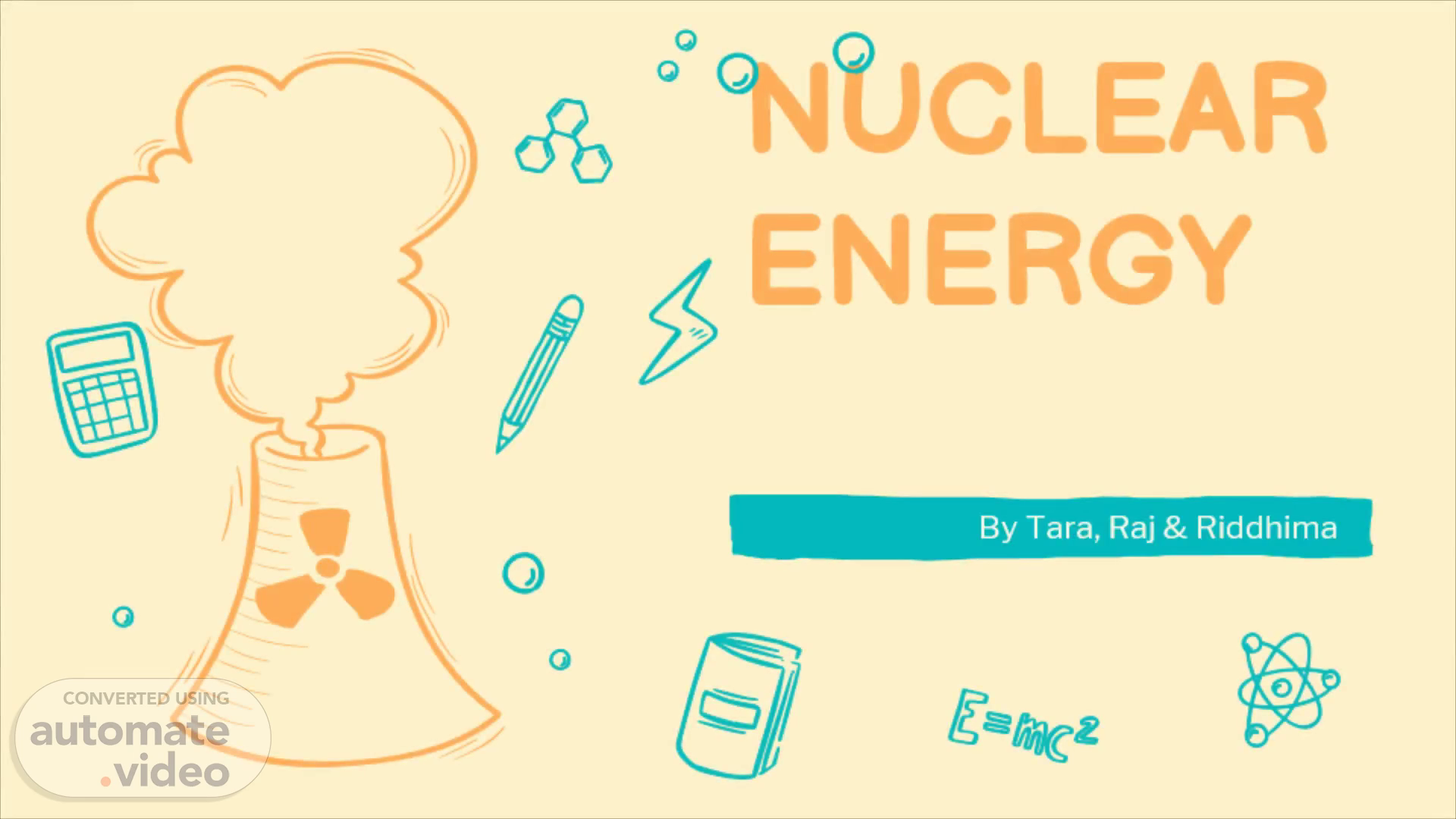Scene 1 (0s)
NUCLEAR ENERGY. By Tara, Raj & Riddhima.
Scene 2 (8s)
02. 01. 05. 04. TABLE OF CONTENTS. Advantages and Disadvantages.
Scene 3 (25s)
03. The discovery of nuclear energy. 01.
Scene 4 (33s)
The discovery of nuclear energy. The idea of nuclear power began in the 1930s , when physicist Enrico Fermi first showed that neutrons could split atoms. Fermi led a team that in 1942 achieved the first nuclear chain reaction, under a stadium at the University of Chicago. This was followed by a series of milestones in the 1950s: the first electricity produced from atomic energy at Idaho's Experimental Breeder Reactor I in 1951; the first nuclear power plant in the city of Obninsk in the former Soviet Union in 1954; and the first commercial nuclear power plant in Shippingport, Pennsylvania, in 1957..
Scene 5 (1m 0s)
03. What is nuclear energy. 02.
Scene 6 (1m 8s)
Nuclear energy originates from the splitting of uranium atoms – a process called fission. In space Uranium is formed naturally occurring in supernovas. However since we can't even travel to the nearest star it is just a minor fact. On Earth Uranium is surprisingly plentiful for a heavy metal. In fact estimate place the Earth's supply of Uranium at 30 times that of SilverThis generates heat to produce steam, which is used by a turbine generator to generate electricity. Because nuclear power plants do not burn fuel, they do not produce greenhouse gas emissions. t's fueled by nuclear reactions that fuse hydrogen atoms together into helium and other heavier elements, releasing huge amounts of energy in the process. In this way, the sun is slowly converting its mass into energy in the form of sunlight, and it has more than enough fuel to last billions of years..
Scene 7 (1m 46s)
03. How is nuclear energy formed?. 03.
Scene 8 (1m 54s)
Nuclear energy originates from the splitting of uranium atoms – a process called fission. This generates heat to produce steam, which is used by a turbine generator to generate electricity. Because nuclear power plants do not burn fuel, they do not produce greenhouse gas emissions..
Scene 9 (2m 12s)
03. The advantages and disadvantages. 03.
Scene 10 (2m 20s)
Advantages of Nuclear Energy. Efficient – 91%! High energy production from a small amount of fuel Low greenhouse gas emissions so it doesn’t contribute to global warming or acid rain Low pollution Reliable 24/7 Cheaper than other energy sources except Hydroelectric We don’t have to rely on other countries for our fuel.
Scene 11 (2m 36s)
Disadvantages Of Nuclear Energy. Storage and disposal of hazardous wastes. Produces Radioactive Waste Potential terrorist applications High startup costs and expenses to close down Danger of meltdown Limited Fuel supply.
Scene 12 (2m 48s)
• Three Mile Island- Harrisburg, PA • Chernobyl – Russia • Fukushima- Japan.
Scene 13 (2m 56s)
NEWS. Three Mile Island- Harrisburg, PA.
Scene 14 (3m 3s)
Chernobyl – Russia.
Scene 15 (3m 9s)
• Fukushima- Japan.
Scene 16 (3m 15s)
03. Where is it used ?. 04.
Scene 17 (3m 24s)
Top five nuclear electricity generation countries, 2019 Country United States France China Russia South Korea Nuclear electricity generation capacity (million kilowatts) 98.12 63.13 45.52 28.37 23.09 Nuclear electricity generation (billion kilowatthours) 809.41 382.40 330.12 195.54 138.81 Nuclear share of country's total electricity generation 19% 5% 18% 25%.
Scene 18 (3m 54s)
03. The future of nuclear energy. 05.
Scene 19 (4m 3s)
Nuclear power provides about 10% of the world's electricity, and 18% of electricity in OECD countries. Almost all reports on future energy supply from major organizations suggest an increasing role for nuclear power as an environmentally benign way of producing reliable electricity on a large scale. Nuclear energy is a powerful source of energy, generated during a nuclear reaction, by change in the nucleus of an atom. The source of nuclear energy is the mass of the nucleus and nuclear energy generated during a nuclear reaction is due to conversion of mass into energy..
Scene 20 (4m 29s)
Fun Facts. About 20% of America’s electricity comes from nuclear energy. Nuclear energy accounts for 56% of our nation's carbon-free electricity. Nuclear plants are the lowest-cost provider of large-scale electricity. Some states generate more than half of their electricity from nuclear power..
Scene 21 (4m 45s)
A PICTURE IS WORTH A THOUSAND WORDS.
Scene 22 (4m 51s)
Nuclear decay. Nuclear fission. Nuclear fusion. NUCLEAR ENERGY.
